How and Why to Feed Bees
Honey bees are, by their nature, foragers, and great ones at that!
Honey bees communicate to each other where local nectar sources are by a dance known as the waggle. As bees are establishing themselves in a new location, they scout out for pollen and nectar sources, and report back to the hive their findings so that other bees know where to fly to.
You might wonder, then, if they're such great foragers and capable of finding pollen and nectar sources on their own, why would a beekeeper ever want or need to feed them?
Why Feed Honey Bees
There are generally two times of the year when a beekeeper will consider feeding their bees. The late fall/early winter and early spring.
When bees live in the hive for the duration of winter, they don't have any external food sources available to them outside of the hive. Nectar is not flowing, and even if it was, it would be too cold for the bees to leave their cluster inside the hive to search for food.
As part of preparing the bees for overwintering, a beekeeper will determine if they have enough stored honey in the hive with them for them to feed on and survive the long winter.
In the St. Louis region, we typically leave 60+ pounds of honey in the hive for the bees. Harvest too much of the honey and they might starve to death. Sometimes the hive is weak going into the winter, and they didn't make enough for themselves, and the beekeeper must help supplement them with sugar syrup.
When provided sugar syrup, the bees will store it in their hives as if it were nectar. They will cap it and consume it during the winter if needed.
The other time of year beekeepers consider feeding their bees is in the early spring. Feeding bees sugar syrup in the spring time before the natural nectar sources are available will help stimulate brood rearing and wax secretion to draw out comb on frames of foundation.
How To Feed Sugar Syrup To Bees
There are several methods to feed sugar syrup to bees including a few that come to mind: Hive Top Feeders, Boardman (entrance feeder), frame feeders, mason jar (gravity feeders) and Ziploc baggie feeders.
This year I have two hives at my house, and one at my father's house. My father will be using a hive top feeder, and I will try both the mason jar (gravity feeders) and Ziploc baggie feeders. This way we'll have experience with three different type feeders in one year.
 Basically a hive top feeder is similar to a trough that sits on top of the hive, under the outer cover.
Basically a hive top feeder is similar to a trough that sits on top of the hive, under the outer cover.
The beekeeper would fill the trough with sugar syrup, and use either screen, or wood floats to allow the bees to stand on so they don't drown. A hive top feeder is nice if you need to feed large amount of syrup to the bees.



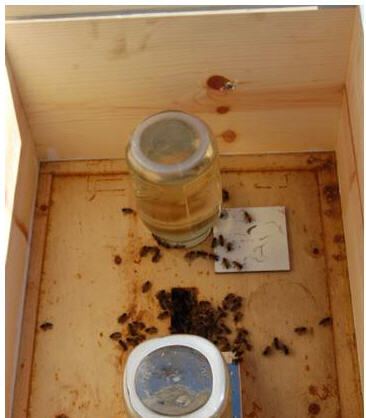 Jar feeders work on the principal of vacuum. Simply fill the jar with sugar syrup, screw on the lid, and punch small holes into the lid. Invert the jar, and after a few drips of syrup fall out, a vacuum will be created, and no more syrup will fall out.
Jar feeders work on the principal of vacuum. Simply fill the jar with sugar syrup, screw on the lid, and punch small holes into the lid. Invert the jar, and after a few drips of syrup fall out, a vacuum will be created, and no more syrup will fall out.
Place the jar over the hole on the inner cover, or place some 1/4 inch strips of wood on the inner cover, and place the jars on the strips of wood. Then, place an empty hive body around the jars, and top with outer cover.
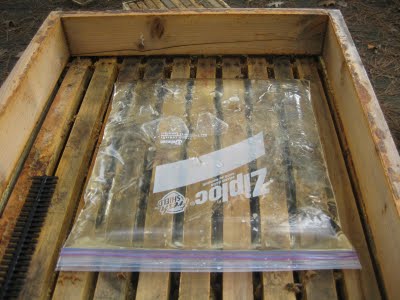 The Ziploc baggie method is new to me, but I can't wait to try it out.
The Ziploc baggie method is new to me, but I can't wait to try it out.
Basically mix the sugar syrup, fill the baggie and zip it closed.
Lay the baggie on the top of the frames, slowly and gently, allowing the bees on top of the frames to move downward out of the way.
Once the bag is lying flat, make several two inch slits in the top of the bag with a sharp knife. The bees will discover the slits in the baggie, and drink the syrup from the slits in the bag until it's empty.
Making Sugar Syrup
Syrup is described as a ratio of sugar to water. Sugar syrup is made either 1:1 in the spring or 2:1 in the winter.
Simply determine how much syrup you will need to fill your feeder(s). If making syrup in the spring time, mix 1 part sugar to 1 part water until dissolved. If making syrup in the fall/winter, mix 2 parts sugar to 1 part water.
The suggested ratio for making syrup for bees on foundation is:
If you have a bucket larger than 2 gallons -
use 12 lbs. (1-1/2 gallon) of granulated cane sugar to
8 lbs (1 gallon) of hot tap water (adding the sugar to the water). Mix well.
This will yield a little over 2 gallons of syrup
I went to my local donuts shop and bought a bunch of 5 gallon buckets from them. The buckets are from icing. They were only a few bucks each, and came with the lids!
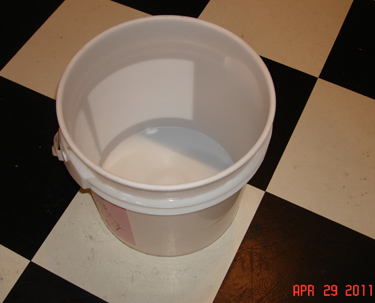
I use hot tap water. If you heat/boil your water first, be sure you don't add the sugar until after you remove the water from the heat. Otherwise the sugar will get too hot and change chemical properties.
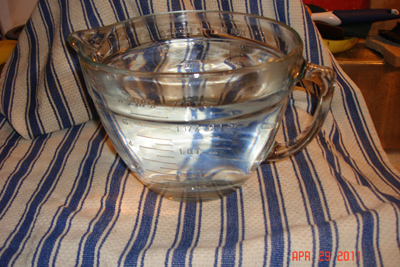
That's a lot of sugar!
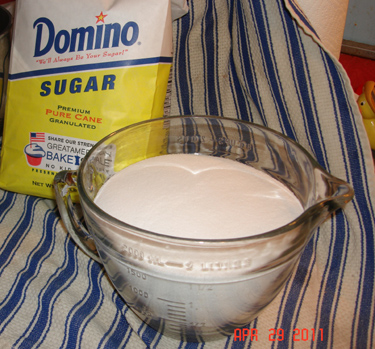
I mix mine right inside the bucket, so that splashes stay in the bucket and not on the counters. You'll want to stir until the water is transparent. There will be a slight discoloration from the sugar, but you should be able to see through the 1:1 mix clearly.
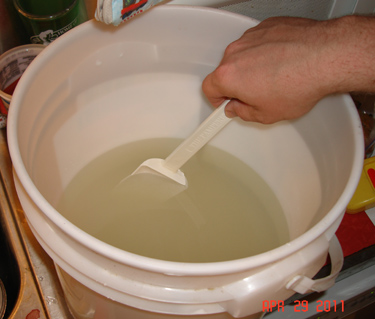
When finished, I funnel it into my quart jars, or into a gallon water jug for easy transporting to the yard.

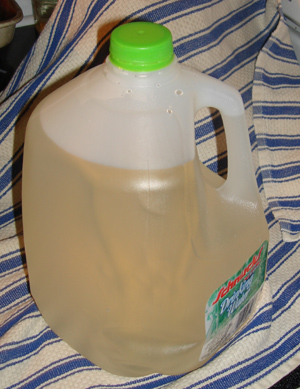
If you have tips or advice on when or how to feed your bees, please share them in the comments section!
Honey bees communicate to each other where local nectar sources are by a dance known as the waggle. As bees are establishing themselves in a new location, they scout out for pollen and nectar sources, and report back to the hive their findings so that other bees know where to fly to.
You might wonder, then, if they're such great foragers and capable of finding pollen and nectar sources on their own, why would a beekeeper ever want or need to feed them?
Why Feed Honey Bees
There are generally two times of the year when a beekeeper will consider feeding their bees. The late fall/early winter and early spring.
When bees live in the hive for the duration of winter, they don't have any external food sources available to them outside of the hive. Nectar is not flowing, and even if it was, it would be too cold for the bees to leave their cluster inside the hive to search for food.
As part of preparing the bees for overwintering, a beekeeper will determine if they have enough stored honey in the hive with them for them to feed on and survive the long winter.
In the St. Louis region, we typically leave 60+ pounds of honey in the hive for the bees. Harvest too much of the honey and they might starve to death. Sometimes the hive is weak going into the winter, and they didn't make enough for themselves, and the beekeeper must help supplement them with sugar syrup.
When provided sugar syrup, the bees will store it in their hives as if it were nectar. They will cap it and consume it during the winter if needed.
The other time of year beekeepers consider feeding their bees is in the early spring. Feeding bees sugar syrup in the spring time before the natural nectar sources are available will help stimulate brood rearing and wax secretion to draw out comb on frames of foundation.
How To Feed Sugar Syrup To Bees
There are several methods to feed sugar syrup to bees including a few that come to mind: Hive Top Feeders, Boardman (entrance feeder), frame feeders, mason jar (gravity feeders) and Ziploc baggie feeders.
This year I have two hives at my house, and one at my father's house. My father will be using a hive top feeder, and I will try both the mason jar (gravity feeders) and Ziploc baggie feeders. This way we'll have experience with three different type feeders in one year.
 Basically a hive top feeder is similar to a trough that sits on top of the hive, under the outer cover.
Basically a hive top feeder is similar to a trough that sits on top of the hive, under the outer cover.The beekeeper would fill the trough with sugar syrup, and use either screen, or wood floats to allow the bees to stand on so they don't drown. A hive top feeder is nice if you need to feed large amount of syrup to the bees.



 Jar feeders work on the principal of vacuum. Simply fill the jar with sugar syrup, screw on the lid, and punch small holes into the lid. Invert the jar, and after a few drips of syrup fall out, a vacuum will be created, and no more syrup will fall out.
Jar feeders work on the principal of vacuum. Simply fill the jar with sugar syrup, screw on the lid, and punch small holes into the lid. Invert the jar, and after a few drips of syrup fall out, a vacuum will be created, and no more syrup will fall out. Place the jar over the hole on the inner cover, or place some 1/4 inch strips of wood on the inner cover, and place the jars on the strips of wood. Then, place an empty hive body around the jars, and top with outer cover.
 The Ziploc baggie method is new to me, but I can't wait to try it out.
The Ziploc baggie method is new to me, but I can't wait to try it out. Basically mix the sugar syrup, fill the baggie and zip it closed.
Lay the baggie on the top of the frames, slowly and gently, allowing the bees on top of the frames to move downward out of the way.
Once the bag is lying flat, make several two inch slits in the top of the bag with a sharp knife. The bees will discover the slits in the baggie, and drink the syrup from the slits in the bag until it's empty.
Making Sugar Syrup
Syrup is described as a ratio of sugar to water. Sugar syrup is made either 1:1 in the spring or 2:1 in the winter.
Simply determine how much syrup you will need to fill your feeder(s). If making syrup in the spring time, mix 1 part sugar to 1 part water until dissolved. If making syrup in the fall/winter, mix 2 parts sugar to 1 part water.
The suggested ratio for making syrup for bees on foundation is:
If you have a bucket larger than 2 gallons -
use 12 lbs. (1-1/2 gallon) of granulated cane sugar to
8 lbs (1 gallon) of hot tap water (adding the sugar to the water). Mix well.
This will yield a little over 2 gallons of syrup
I went to my local donuts shop and bought a bunch of 5 gallon buckets from them. The buckets are from icing. They were only a few bucks each, and came with the lids!

I use hot tap water. If you heat/boil your water first, be sure you don't add the sugar until after you remove the water from the heat. Otherwise the sugar will get too hot and change chemical properties.

That's a lot of sugar!

I mix mine right inside the bucket, so that splashes stay in the bucket and not on the counters. You'll want to stir until the water is transparent. There will be a slight discoloration from the sugar, but you should be able to see through the 1:1 mix clearly.

When finished, I funnel it into my quart jars, or into a gallon water jug for easy transporting to the yard.


If you have tips or advice on when or how to feed your bees, please share them in the comments section!
Replica Watches, Audemars Piguet Replica, Rolex Replica, Hublot Replica, Hublot Replica, Rado Replica, Richard Mille Replica, Panerai Replica, Patek Philippe Replica, Tag Heuer Replica, Vacheron Constantin Replica
Comments For This Post: (1) | Post Your Comments! Hide The Comment Form